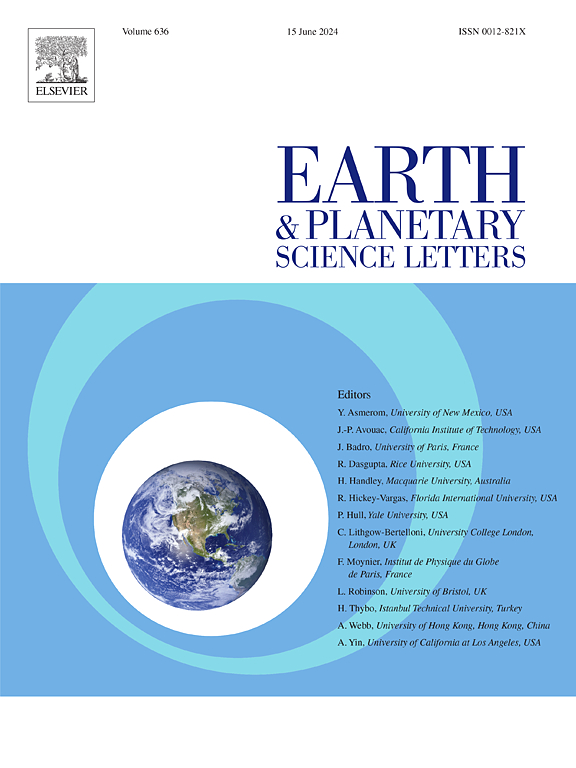大陆俯冲工厂中铁-硫-碳氧化还原作用及其对地幔楔中挥发性元素储存的影响
IF 4.8
1区 地球科学
Q1 GEOCHEMISTRY & GEOPHYSICS
引用次数: 0
摘要
乌尔腾区构造混杂区的超基性岩经历了有据可查的多阶段变质历史,从停留在热地幔楔中,到向下拖曳并被困在变质板块中,同时伴有闪长岩化,最后经历了两个阶段的掘出,同时伴有氯化物化和蛇纹石化。我们以这些岩石为天然实验室,研究大陆俯冲带中的挥发性元素通量是否会促进上覆地幔楔中挥发性元素的长期储存。在这里,我们获得了有关超基性块岩的化学成分、铁标本、碳浓度和同位素组成,以及来自>10个超基性透镜体样品中碳酸盐的碳氧同位素组成的新数据,并将这些数据与之前发表的数据相结合,以获得更多的见解。碳酸盐稳定同位素组成显示出明显的省区性,即来自东北乌尔腾区域小逆冲超基性透镜体的岩石具有较低的平均δ13CV-PDB和δ18OV-SMOW,分别为-16.分别为-16.8‰至-5.7‰和+8.0‰至+17.8‰,表明有不同的地壳流体流入。大块岩石的碳含量从130到28,000微克克-1不等,超过了对流地幔的估计值,东北域岩石的碳含量平均较高(中位数为880微克克-1),这可以模拟为雷利式白云岩在800-700 °C时的添加。西南域岩石的C含量较低(中位数为570 μg g-1),与δ13C呈正相关,可模拟为在∼500-400 °C时的雷利式方解石添加。最低的δ13C和C含量表明在低温(400 °C)蛇绿岩化过程中发生了脱熔作用,并进一步表明13C贫化相对大块岩石成分的贡献。在前瓦利斯坎大陆岩石圈形成过程中熔体耗竭之后,硫存量在接近变质峰值条件的闪长岩化过程中通过与硅质流体相互作用的硫化作用得到补充。在与掘起有关的过程中,硫被明显(重新)消耗,这反映了氯化和蛇绿岩化过程中硫的低赋存。现有数据表明,大块岩石的高Fe3+/ΣFe(中位数为0.18)是由于在闪长岩化过程中一些硫酸盐水溶液被还原,同时伴有氧化还原中性的碳酸盐化,以及在硫富集度较低的氯化物化过程中碳酸盐被还原造成的。这些物质随后稳定在碰撞造山带之下,碰撞造山带覆盖了地球大陆的广大区域,可能构成了富含挥发性元素的岩石圈地幔储层。本文章由计算机程序翻译,如有差异,请以英文原文为准。
Iron-sulfur-carbon redox interactions in the continental subduction factory and their effect on volatile element storage in the mantle wedge
The ultramafic rocks of the Ulten Zone tectonic mélange experienced a well-documented multi-stage metamorphic history, from residence in a hot mantle wedge to down-dragging and trapping in a Variscan slab accompanied by amphibolitisation, and finally two-stage exhumation accompanied by chloritisation and serpentinisation. We use these rocks as a natural laboratory to investigate whether volatile element fluxes in continental subduction zones promote long-term volatile element storage in the overlying mantle wedge. Here, we obtained new data on the chemical composition, iron speciation, carbon concentrations and isotopic compositions of ultramafic bulk rocks, and the carbon-oxygen isotope composition of carbonates in samples from >10 ultramafic lenses, which we combine with previously published data for additional insights.
The carbonate stable isotope compositions show a distinct provinciality, whereby rocks from the little retrogressed ultramafic lenses in the NE Ulten Zone domain have lower average δ13CV-PDB and δ18OV-SMOW of –16.8‰ to –5.7‰ and +8.0‰ to +17.8‰, respectively, than those in the more retrogressed SW domain (–11.2‰ to 0.0‰ and +12.9‰ to +20.7‰, respectively), suggesting influx of distinct crustal fluids. Bulk-rock carbon contents range from 130 to 28,000 μg g-1, exceeding estimates for the convecting mantle, and are on average higher in rocks from the NE domain (median 880 μg g-1), which can be modelled as Rayleigh-style dolomite addition at ∼800–700 °C. Rocks from the SW domain have lower C contents (median 570 μg g-1) which correlate positively with δ13C and can be modelled as Rayleigh-style calcite addition at ∼500–400 °C. The lowest δ13C and C contents point to dedolomitisation during low-temperature (400 °C) serpentinisation, and furthermore suggest the contribution of a 13C-depleted phase to the bulk-rock compositions.
After melt depletion during formation of the pre-Variscan continental lithosphere, the sulfur inventory was replenished during amphibolitisation near peak-metamorphic conditions, via sulphidation during interaction with siliceous fluid. Sulfur was markedly (re-)depleted during processes related to exhumation, reflecting low sulfur fugacity during chloritisation and serpentinisation. The available data suggest that the high bulk-rock Fe3+/ΣFe (median 0.18) resulted from reduction of some aqueous sulphate during amphibolitisation, accompanied by redox-neutral carbonation, and from carbonate reduction during chloritisation when sulfur fugacity was low.
Ignoring exhumation-related C loss and taking near-peak metamorphic conditions as representative, significant amounts of C in carbonates and water in amphiboles may be stored in continental mantle wedges. These are subsequently stabilised below collisional orogens, which cover vast areas of Earth's continents and possibly constitute particularly volatile element-rich lithospheric mantle reservoirs.
求助全文
通过发布文献求助,成功后即可免费获取论文全文。
去求助
来源期刊

Earth and Planetary Science Letters
地学-地球化学与地球物理
CiteScore
10.30
自引率
5.70%
发文量
475
审稿时长
2.8 months
期刊介绍:
Earth and Planetary Science Letters (EPSL) is a leading journal for researchers across the entire Earth and planetary sciences community. It publishes concise, exciting, high-impact articles ("Letters") of broad interest. Its focus is on physical and chemical processes, the evolution and general properties of the Earth and planets - from their deep interiors to their atmospheres. EPSL also includes a Frontiers section, featuring invited high-profile synthesis articles by leading experts on timely topics to bring cutting-edge research to the wider community.
 求助内容:
求助内容: 应助结果提醒方式:
应助结果提醒方式:


